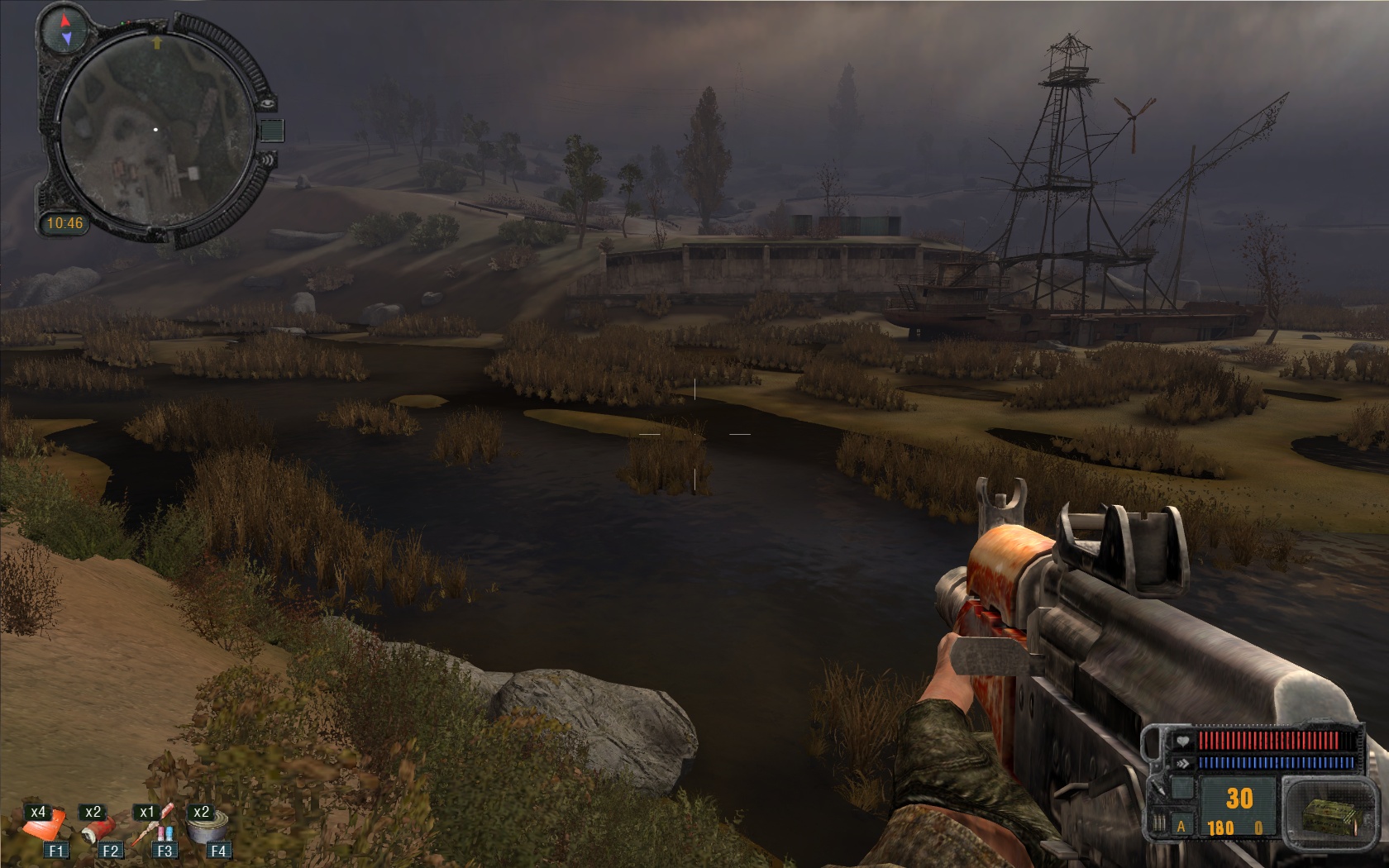|
Ken's Labyrinth
''Ken's Labyrinth'' is a first-person shooter for MS-DOS published in 1993 by Epic MegaGames. It was programmed by Ken Silverman, who later designed the Build engine used for rendering in 3D Realms's ''Duke Nukem 3D'' (1996). ''Ken's Labyrinth'' consists of three episodes, the first of which was released as shareware. An earlier version was self-published by Silverman. In the game, the player assumes the role of a faceless person trying to rescue their dog, Sparky, from a labyrinth. Technology ''Ken's Labyrinth'' is graphically similar to id Software's ''Wolfenstein 3D'' in that the levels were designed using a grid-based plane, resulting in perpendicular walls and textureless floors and ceilings. Arguably its most astounding feature was the existence of interactive sprites and textures, like slot and vending machines. This move towards engines allowing greater interactivity was later elaborated upon by Silverman's Build engine. ''Ken's Labyrinth'' was released as freeware on ... [...More Info...] [...Related Items...] OR: [Wikipedia] [Google] [Baidu] |
First-person Shooter
A first-person shooter (FPS) is a video game genre, video game centered on gun fighting and other weapon-based combat seen from a First person (video games), first-person perspective, with the player experiencing the action directly through the eyes of the player character, main character. This genre shares multiple common traits with other shooter video games, shooter games, and in turn falls under the action games category. Since the genre's inception, advanced 3D computer graphics, 3D and 2.5D, pseudo-3D graphics have proven fundamental to allow a reasonable level of immersion in the three-dimensional space, game world, and this type of game helped pushing technology progressively further, challenging hardware developers worldwide to introduce numerous innovations in the field of graphics processing units. Multiplayer video game, Multiplayer gaming has been an integral part of the experience, and became even more prominent with the diffusion of internet connectivity in recen ... [...More Info...] [...Related Items...] OR: [Wikipedia] [Google] [Baidu] |
Ken Silverman
Ken Silverman (born November 1, 1975) is an American game programmer, best known for writing the Build (game engine), Build engine. It was most notably utilized by ''Duke Nukem 3D'', ''Shadow Warrior'', ''Blood (video game), Blood'', and more than a dozen Build engine#List of Build Engine games, other games in the mid- to late-1990s. Once considered the primary rival of John D. Carmack, John Carmack (later succeeded by Tim Sweeney (game developer), Tim Sweeney), Silverman started work on the Build engine sometime before his first semester at Brown University in 1993, under a contract with 3D Realms, Apogee Software. In the wake of ''Duke Nukem 3D'' and other Build engine games, Silverman left the commercial game industry. Silverman has been CTO and co-founder of Ardfry Imaging, LLC responsible for the PNG Compression tool PNGOUT. He is the founder and Chief Computer Scientist of VOXON, makers of the world's most advanced 3D volumetric display system. Projects Ken's Laby ... [...More Info...] [...Related Items...] OR: [Wikipedia] [Google] [Baidu] |
Freeware
Freeware is software, often proprietary, that is distributed at no monetary cost to the end user. There is no agreed-upon set of rights, license, or EULA that defines ''freeware'' unambiguously; every publisher defines its own rules for the freeware it offers. For instance, modification, redistribution by third parties, and reverse engineering are permitted by some publishers but prohibited by others. Unlike with free and open-source software, which are also often distributed free of charge, the source code for freeware is typically not made available. Freeware may be intended to benefit its producer by, for example, encouraging sales of a more capable version, as in the freemium and shareware business models. History The term ''freeware'' was coined in 1982 by Andrew Fluegelman, who wanted to sell PC-Talk, the communications application he had created, outside of commercial distribution channels. Fluegelman distributed the program via the same process as ''shareware''. As s ... [...More Info...] [...Related Items...] OR: [Wikipedia] [Google] [Baidu] |
Dragon (magazine)
''Dragon'' was one of the two official magazines for source material for the ''Dungeons & Dragons'' role-playing game and associated products, along with ''Dungeon (magazine), Dungeon''. TSR, Inc. originally launched the monthly printed magazine in 1976 to succeed the company's earlier publication, ''The Strategic Review''. The final printed issue was #359 in September 2007. Shortly after the last print issue shipped in mid-August 2007, Wizards of the Coast (part of Hasbro, Inc.), the publication's current copyright holder, relaunched ''Dragon'' as an online magazine, continuing on the numbering of the print edition. The last published issue was No. 430 in December 2013. A digital publication called ''Dragon+'', which replaced ''Dragon'' magazine, was launched in 2015. It was created by the advertising agency Dialect in collaboration with Wizards of the Coast, and its numbering system for issues started at No. 1. History TSR In 1975, TSR, Inc. began publishing ''The Strate ... [...More Info...] [...Related Items...] OR: [Wikipedia] [Google] [Baidu] |
Nintendo Switch
The is a video game console developed by Nintendo and released worldwide in most regions on March 3, 2017. Released in the middle of the Eighth generation of video game consoles, eighth generation of home consoles, the Switch succeeded the Wii U and competed with Sony Interactive Entertainment, Sony's PlayStation 4 and Microsoft's Xbox One; it also competes with the Ninth generation of video game consoles, ninth generation consoles, the PlayStation 5 and Xbox Series X and Series S, Xbox Series X/S. The Switch is a Tablet computer#Gaming tablet, tablet that can either be docking station, docked for home video game console, home console use or used as a handheld game console, portable device, making it a Video game console#Hybrid video game consoles, hybrid console. Its wireless Joy-Con controllers function as two halves of a standard controller and alternatively as individual controllers, featuring buttons, directional analog sticks for user input, motion sensing, and tactile ... [...More Info...] [...Related Items...] OR: [Wikipedia] [Google] [Baidu] |
Linux
Linux ( ) is a family of open source Unix-like operating systems based on the Linux kernel, an kernel (operating system), operating system kernel first released on September 17, 1991, by Linus Torvalds. Linux is typically package manager, packaged as a Linux distribution (distro), which includes the kernel and supporting system software and library (computing), libraries—most of which are provided by third parties—to create a complete operating system, designed as a clone of Unix and released under the copyleft GPL license. List of Linux distributions, Thousands of Linux distributions exist, many based directly or indirectly on other distributions; popular Linux distributions include Debian, Fedora Linux, Linux Mint, Arch Linux, and Ubuntu, while commercial distributions include Red Hat Enterprise Linux, SUSE Linux Enterprise, and ChromeOS. Linux distributions are frequently used in server platforms. Many Linux distributions use the word "Linux" in their name, but the Free ... [...More Info...] [...Related Items...] OR: [Wikipedia] [Google] [Baidu] |
Microsoft Windows
Windows is a Product lining, product line of Proprietary software, proprietary graphical user interface, graphical operating systems developed and marketed by Microsoft. It is grouped into families and subfamilies that cater to particular sectors of the computing industry – Windows (unqualified) for a consumer or corporate workstation, Windows Server for a Server (computing), server and Windows IoT for an embedded system. Windows is sold as either a consumer retail product or licensed to Original equipment manufacturer, third-party hardware manufacturers who sell products Software bundles, bundled with Windows. The first version of Windows, Windows 1.0, was released on November 20, 1985, as a graphical operating system shell for MS-DOS in response to the growing interest in graphical user interfaces (GUIs). The name "Windows" is a reference to the windowing system in GUIs. The 1990 release of Windows 3.0 catapulted its market success and led to various other product families ... [...More Info...] [...Related Items...] OR: [Wikipedia] [Google] [Baidu] |
Future Crew
Future Crew was a Finnish demogroup that created PC demos and software, active mostly between 1987 and 1994. History The group was founded in 1986 by PSI (Sami Tammilehto) and JPM (Jussi Markula) as a Commodore 64 group, before moving to the PC demoscene in 1988; other members included, over time, Trug, Wildfire, Pixel In digital imaging, a pixel (abbreviated px), pel, or picture element is the smallest addressable element in a Raster graphics, raster image, or the smallest addressable element in a dot matrix display device. In most digital display devices, p ..., ICE, GORE, Abyss, Purple Motion, and Skaven, as well as several others. Noteworthy demos by Future Crew include ''Unreal'' (released at Assembly 1992), '' Panic'' (released at The Party 1992) and '' Second Reality'' (released at Assembly 1993). Second Reality may be considered one of the most influential PC demos ever made. Future Crew was also responsible for the popular MOD editor '' Scream Tracker'', whi ... [...More Info...] [...Related Items...] OR: [Wikipedia] [Google] [Baidu] |
Misko Iho
Misko Iho (born Mikko Iho; May 9, 1975) is a Finnish film director. In the mid 1990s, he was part of the computer demo group Future Crew, and later worked designing computer game graphics in the United States. He also worked in organizing a number of music events, and later as a commercial and music video director - winning a number of Finnish and international awards. Life and work Misko Iho was born on May 9, 1975, as Mikko Iho in Helsinki, Finland. From 1992 to 1994, Iho was a part of a now-defunct computer demo group, Future Crew, as the graphic artist named "Pixel". Noteworthy demos by Future Crew include '' Unreal'' (released at Assembly 1992), ''Panic'' (released at The Party 1992), and '' Second Reality'' (released at Assembly 1993). Slashdot voted ''Second Reality'' as one of the "Top 10 Hacks of All Time". During 1994, Iho spent a few months in the United States designing computer game graphics for the game '' Epic Pinball'' by Epic MegaGames as well as ''Ken's L ... [...More Info...] [...Related Items...] OR: [Wikipedia] [Google] [Baidu] |
Melee Combat
A melee ( or ) is a confused hand-to-hand fight among several people. The English term ''melee'' originated circa 1648 from the French word ' (), derived from the Old French ''mesler'', from which ''medley'' and ''meddle'' were also derived. The 1812 tabletop wargame ''Kriegsspiel'', and H.G. Wells' 1913 ''Little Wars'', referred to the hand-combat stage of the game as a ''melée,'' or ', respectively. The term was brought over to tabletop role-playing games such as ''Dungeons & Dragons'', and in turn to role-playing video games, to describe any close-combat encounter. See also *Combatives Combatives is the term used to describe the hand-to-hand combat systems primarily used by members of the military, law enforcement, or other groups such as security personnel or correctional officers. Combatives are based in martial arts but a ... * References {{Reflist Combat Military science ... [...More Info...] [...Related Items...] OR: [Wikipedia] [Google] [Baidu] |





